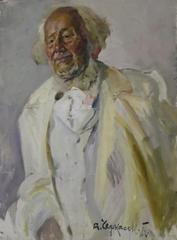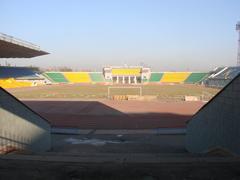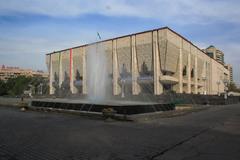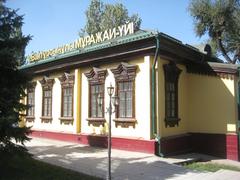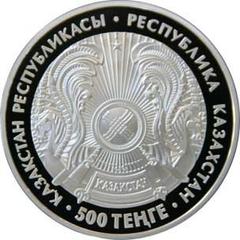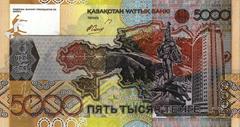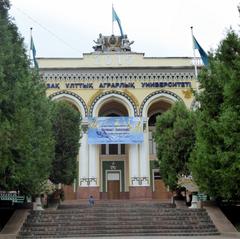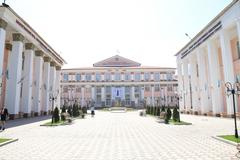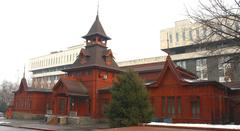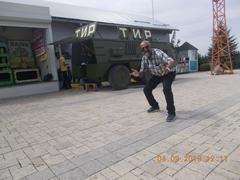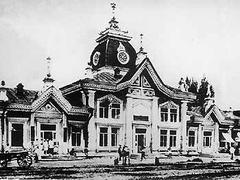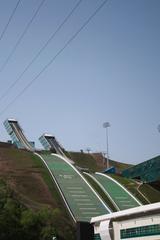Abay Monument in Almaty, Kazakhstan: Visiting Hours, Tickets, and Historical Significance
Date: 03/07/2025
Introduction
The Abay Monument in Almaty is a profound symbol of Kazakhstan’s cultural and intellectual heritage. Dedicated to Abay Kunanbaiuly (1845–1904), a visionary poet, philosopher, and national reformer, the monument pays tribute to a figure whose influence shaped modern Kazakh identity. Abay’s integration of Kazakh oral traditions with Russian and European literary forms—epitomized in his seminal work “The Book of Words” (Kara Sozder)—sparked a renaissance in Kazakh literature and education (Trip.com; KazGuidedTours).
Almaty, Kazakhstan’s historic capital, reflects a unique blend of Silk Road origins, Soviet architecture, and modern vibrancy. The Abay Monument stands prominently on Abay Avenue, a dynamic cultural corridor lined with theaters, museums, and cafes, all reflecting the city’s creative energy (MakeMyTrip).
Accessible year-round and free to visit, the monument sits in a pedestrian-friendly zone near the Abay Metro station. Beyond the statue, visitors can immerse themselves in the surrounding district’s rich cultural offerings, including the renowned Abay Opera and Ballet Theater and a host of seasonal festivals (Wikipedia; gocomgo.com; Trek.Zone; Caravanistan).
This guide provides comprehensive insights into visiting the Abay Monument: its history, significance, practical details, and how to enrich your Almaty experience with local cuisine, cultural etiquette, and nearby attractions (Trip.com; KazGuidedTours; MakeMyTrip).
Abay Kunanbaiuly: Legacy and Impact
Abay Kunanbaiuly is recognized as the father of modern Kazakh literature. Born in the Semipalatinsk region, he championed education, enlightenment, and moral development, infusing his works with philosophical depth and advocating for social reform. Abay’s writing was shaped by Kazakh traditions and a cosmopolitan appreciation for Russian and European literature—he notably translated Pushkin, Goethe, and Byron into Kazakh, broadening cultural horizons for his people. His treatise, “The Book of Words,” remains a cornerstone of Kazakh thought (Trip.com).
Abay’s legacy endures as a touchstone of national consciousness. During the late 19th and early 20th centuries—an era of Russian imperial dominance—his call for rationalism, tolerance, and education inspired generations. UNESCO honored his centenary, and today, Abay’s works are integral to Kazakhstan’s educational curriculum and public life (KazGuidedTours).
Almaty: The City’s Cultural Evolution
Almaty, formerly Alma-Ata, is Kazakhstan’s largest and most cosmopolitan city. Founded as a Russian outpost on ancient Silk Road territory, it became the Soviet republic’s capital and a hub for science, culture, and the arts. The city’s urban landscape is a tapestry of Soviet-era monuments, neoclassical buildings, and modern skyscrapers interwoven with Kazakh motifs (MakeMyTrip).
The Republic Palace and Abay Monument, both prominent on Abay Avenue, are central to the city’s identity. The monument, installed in 1960, features a contemplative bronze statue of Abay and serves as a gathering place for civic events and cultural celebrations (Trip.com; KazGuidedTours).
Abay Avenue itself is the city’s cultural artery, home to key institutions and public spaces that embody the enlightenment values Abay championed (MakeMyTrip).
Visiting the Abay Monument: Hours, Tickets, and Access
- Hours: Open 24/7, year-round; as an outdoor public space, there are no restricted visiting hours (Trip.com).
- Tickets: No entrance fee or ticket is required.
- Guided Tours: Numerous agencies offer guided walking tours that include the Abay Monument, providing context and in-depth history (KazGuidedTours).
- Location: In front of the Republic Palace, easily accessible via the Almaty Metro (Abay station), city buses, taxis, and on foot (Goniyo Community).
- Accessibility: The monument area is wheelchair-friendly and has nearby public facilities.
Cultural Practices and Modern-Day Relevance
Abay’s influence permeates Kazakh society. His teachings are celebrated through public readings, musical adaptations, and commemorative events at the monument, particularly on national holidays and his birthday. Laying flowers at the statue is a common gesture of respect (KazGuidedTours).
Almaty’s multicultural vibrancy is reflected in festivals like the Almaty Jazz Festival and Nauryz Meyrami, often hosted near the monument. The surrounding district brims with theaters, galleries, and restaurants, echoing Abay’s spirit of openness and creativity (MakeMyTrip).
Practical Visitor Insights
- Best Time to Visit: June–September for comfortable weather (Wanderlog).
- Language: Russian and Kazakh are primary; English is increasingly spoken in tourist areas.
- Transport: Almaty Metro and Yandex Taxi offer reliable access. The monument’s location is central and easily walkable (Goniyo Community).
- Cultural Etiquette: Modest attire and respectful behavior are appreciated, especially during ceremonies.
- Local Cuisine: Try nearby restaurants for beshbarmak, baursak, and other Kazakh specialties (KazGuidedTours).
- Nearby Attractions: Panfilov Park, Zenkov Cathedral, Green Bazaar, and Kok-Tobe Hill are all within easy reach for an extended cultural itinerary (GoKite Travel).
Abay Opera and Ballet Theater: A Cultural Highlight
The Abay Opera and Ballet Theater is a crown jewel of Almaty’s performing arts scene. Founded in the 1930s and named for Abay in 1945, the theater’s architecture fuses Stalinist grandeur, Italian Neoclassicism, and Kazakh motifs (gocomgo.com). Its auditorium, seating 793, is renowned for acoustics and elegance (kazakhstan-tourism.com).
Notable features:
- Performances: Kazakh operas, ballets, and international works, plus guest productions (operabase.com).
- Visiting Hours: Box office open 10:00 AM–6:00 PM; performances typically on weekends (littleadventurertravels.com).
- Tickets: From 1,500 KZT (~$5.80 AUD); purchase online or at the box office (gatob.kz).
- Location: 110 Kabanbay Batyr Street, near Almaly metro (welcome.kz).
- Accessibility: Wheelchair access and assistance services available.
Smart attire is recommended for performances; photography is not allowed during shows (shetravelsabroad.com). Guided tours of the theater are available for a deeper dive into its history and architecture.
The Abay District: Attractions, Events, and Visitor Information
The Abay District is a lively cultural enclave featuring:
- Abay Opera House (Abay Opera House): Neoclassical landmark with a robust performance calendar.
- Abay Square (Abay Square): Venue for festivals and gatherings.
- Central State Museum (Central State Museum): Open Tuesday–Sunday, 10:00 AM–6:00 PM.
- Panfilov Street Promenade: Lined with cafes and boutiques for evening strolls.
- Festivals: Nauryz Meyrami (March), Almaty Marathon, Jazz Festival, and Apple Festival highlight the district’s calendar.
Getting Around: The area is well-served by public transit (Abay Metro), and is safe and accessible for tourists (Caravanistan).
Hidden Gems: Discover off-the-beaten-path art galleries and Soviet-era architecture, or visit the Bobek Monument for quiet reflection.
Visiting the Abay Monument: Detailed Practical Guide
- Hours: Open dawn to dusk (approx. 6:00 AM–10:00 PM), no entry fee.
- Getting There: Almaty Metro (Abay station) is a 5-minute walk; taxis and bus routes are available.
- Nearby Sites: Panfilov Park, Zenkov Cathedral, and Green Bazaar are within walking distance.
- Tours: Local agencies offer guided walks that include Abay and related sites.
- Accommodation: Options range from hostels to luxury hotels; Dostyk Avenue and Panfilov Street are popular for visitors.
- Safety: The area is tourist-friendly and safe; standard precautions apply.
- Weather: Best visited in spring or autumn for mild temperatures.
- Dining: Abundant options nearby for traditional Kazakh and international cuisine.
- Accessibility: Metro stations and public spaces are equipped with ramps and elevators.
Frequently Asked Questions (FAQ)
Q: What are the Abay Monument’s opening hours?
A: Open 24 hours; no restricted hours.
Q: Is there an entrance fee?
A: No, it’s free to visit.
Q: How do I get there by public transport?
A: Take the Almaty Metro to Abay station; buses and Yandex Taxi are also options.
Q: Are guided tours available?
A: Yes, many agencies offer tours including the monument.
Q: What other attractions are nearby?
A: Panfilov Park, Zenkov Cathedral, Green Bazaar, and the Central State Museum.
Q: Is the area safe?
A: Yes, standard urban precautions apply.
Q: Can I take photos?
A: Yes, in public spaces—always ask before photographing people.
Conclusion
The Abay Monument stands at the intersection of Kazakhstan’s history, culture, and modernity. Its central location, cultural significance, and accessibility make it an essential stop for any visitor to Almaty. Nearby, the Abay Opera and Ballet Theater and the broader Abay District offer a wealth of experiences—from world-class performances and museums to vibrant festivals and authentic local cuisine.
For an enriched visit, leverage digital resources like the Audiala app for self-guided tours and real-time information. Stay updated with local events, and take time to explore the city’s unique blend of tradition and innovation.
For the latest information, always consult official Almaty tourism websites and local guides.
Sources
- Trip.com
- KazGuidedTours
- MakeMyTrip
- Wikipedia
- GoComGo
- Kazakhstan Tourism
- Trek.Zone
- Caravanistan
- Goniyo Community
- Green Bazaar, GoKite Travel
- OperaBase
- Little Adventurer Travels
- Welcome.kz
- She Travels Abroad
- Secret Attractions






